
The northern snakehead is a species of snakehead fish native to temperate East Asia, in China, Russia, North Korea, and South Korea. Their natural range goes from the Amur River watershed in Siberia and Manchuria down to Hainan. It is an important food fish and one of the most cultivated in its native region, with an estimated 500 tons produced every year in China and Korea alone. Due to this, the northern snakehead has been exported throughout the world and has managed to establish non-native populations in Central Asia and North America.
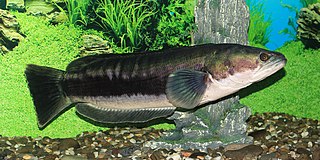
Channa is a genus of predatory fish in the family Channidae, commonly known as snakeheads, native to freshwater habitats in Asia. This genus contains about 50 scientifically described species. The genus has a wide natural distribution extending from Iraq in the west, to Indonesia and China in the east, and parts of Siberia in the Far East. A particularly high richness of species exists in Myanmar (Burma) and northeastern India, and many Channa species live nowhere else. In contrast, a few widespread species have been introduced to several regions outside their natural range, where they often become invasive. The large and medium-sized Channa species are among the most common staple food fish in several Asian countries, and they are extensively cultured. Apart from their importance as a food fish, snakeheads are consumed in some regions as a traditional medicine for wound healing and reducing postoperative pain and discomfort, and collected for the international aquarium pet trade.
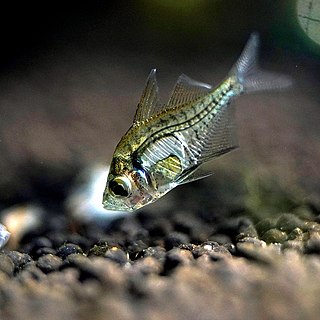
Parambassis ranga, commonly known as the Indian glassy fish, Indian glassy perch, or Indian X-ray fish, is a species of freshwater fish in the Asiatic glassfish family Ambassidae of order Perciformes. It is native to an area of South Asia from Pakistan to Vietnam, Malaysia and Bangladesh.

The snakeheads are members of the freshwater perciform fish family Channidae, native to parts of Africa and Asia. These elongated, predatory fish are distinguished by their long dorsal fins, large mouths, and shiny teeth. They breathe air with gills, which allows them to migrate short distances over land. They have suprabranchial organs, which are primitive forms of labyrinth organs, that develop when they grow older. The two extant genera are Channa in Asia and Parachanna in Africa, consisting of more than 50 species.

The term coldwater fish can have different meanings in different contexts.

Channa bleheri is a species of dwarf snakehead that is endemic to the Brahmaputra River basin in the Indian states of Assam and Arunachal Pradesh. It is among the most colorful species of snakehead.

Dwarf snakehead is a term coined by aquarists to describe a group of Channa snakehead fishes growing to about 25 cm (10 in) maximum. They are found in freshwater habitats in South and Southeast Asia, and southern China.

The forest snakehead is a species of snakehead, a fish of the family Channidae. Its range includes most of Southeast Asia and parts of southern China. It lives in forest streams and can reach 40 cm (16 in) in length. The forest snakehead is known in Thai language as pla krasong. Khmer language called it កញ្ជនជៃ, Indonesians named it kehung, while in Malaysia, they called it ikan bujuk in Malay Language and in Vietnamese its name is cá lóc dày

Channa gachua, the dwarf snakehead, is a species of fish in the family Channidae. The name "dwarf snakehead" is also used for several other species of small snakeheads. C. gachua is native to freshwater habitats in southern Asia, where it has a wide distribution from Iran to Indonesia. This fish is considered to be a species complex, a group of several closely related taxa with one name. It is likely at least three to four different species, and further research may differentiate them. A few species such as Channa harcourtbutleri have been separated from the complex in recent decades. The easternmost population of C. gachua is often recognized as a separate species C. limbata, while the isolated Sri Lankan population often is recognized as C. kelaartii.

Channa striata, the striped snakehead, is a species of snakehead fish. It is also known as the common snakehead, chevron snakehead, or snakehead murrel and generally referred simply as mudfish. It is native to South and Southeast Asia, and has been introduced to some Pacific Islands. Reports from Madagascar and Hawaii are misidentifications of C. maculata.

Channa marulius is a large species of snakehead native to South Asia. Populations in Southeast Asia are now regarded as separate species.

The Malabar snakehead is a vulnerable species of snakehead from fresh water in the Western Ghats in India. Until 2011, its scientific name was usually considered to be a synonym of C. micropeltes, the giant snakehead.
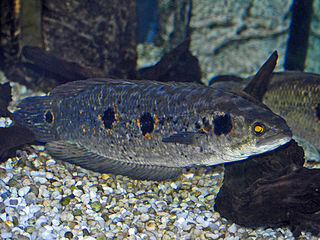
Channa pleurophthalma, the ocellated snakehead is a species of Southeast Asian freshwater fish in the snakehead family.
Heiko Bleher is a German researcher, author, photographer, and filmmaker. He is best known in the scientific community for his contribution to the exploration of fresh and brackish water habitats worldwide. He has discovered numerous species of fish and aquatic plant, several of which carry his name or are named in honor of Bleher's family.
Channa stewartii is a species of dwarf snakehead in the family Channidae, which is native to Nepal and the Indian states of Arunachal Pradesh, Assam, Manipur, Meghalaya, Nagaland and Tripura. It may also be found in Bangladesh. This freshwater fish mostly inhabits hill streams, but can also be found in ponds. It is of little value as a food fish but common in the aquarium trade.
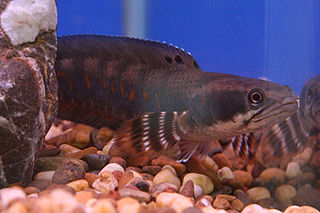
Channa pulchra is a species of snakehead fish in the family Channidae which is native to Myanmar. It was first described in 2007 by R. Britz from a specimen collected from the Kyeintali Chaung (stream) basin in Rakhine Yoma, western Myanmar. The fish is found in streams that are fast flowing, clear, highly oxygenated and relatively cold (subtropical). It is of little food value but getting popularity as an aquarium fish recently.
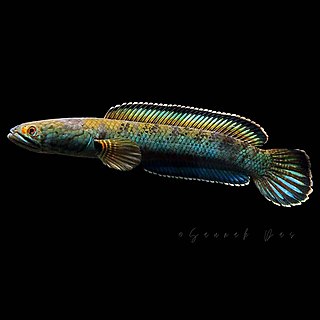
Channa pardalis is a species of dwarf snakehead in the genus Channa. It was first described in 2016 from Khasi Hills, Meghalaya of northeastern India. Prior to its scientific description, it was known as Channa sp. "True Blue" or Channa sp. "Meghalaya" in the aquarium trade, although some claim that "Meghalaya" is another, still undescribed species. C. pardalis is closely related to C. bipuli and C. stewartii.
Channa royi, the Andaman emerald snakehead, is a species of snakehead fish endemic to the Andaman and Nicobar Islands of India. This dwarf snakehead is distinct from other snakehead species due to its differing coloration, number of vertebrae, and teeth, most notably its greenish-gray dorsum. It was only scientifically described in 2018 and its closest relative is the Burmese snakehead, and a review in 2019 argued that the two are synonyms.

Aenigmachanna gollum, the Gollum snakehead, is a species of aquifer-dwelling dragon snakehead fish that is endemic to the Indian state of Kerala.

Channa aurolineata is a species of Asian snakehead in the family Channidae. It is found natively in most of Myanmar's waterways as well as the Mae Khlong drainage in Thailand. There is also an invasive population found in Southeast Florida, United States. This species was recently split from C. marulius, the bullseye snakehead, and confirmed as a separate species in 2018; and the Florida and Thailand populations were not discovered to be C. aurolineata until even more recently in 2019. Before this, the Thailand population's species was unknown and the Florida ones were assumed to be C. marulius. C. aurolineata was able to be separated as a new species and identified in other areas due to slight differences in color pattern, lateral line scale and fin ray morphology, and DNA structure from the other species in the marulius complex.






















